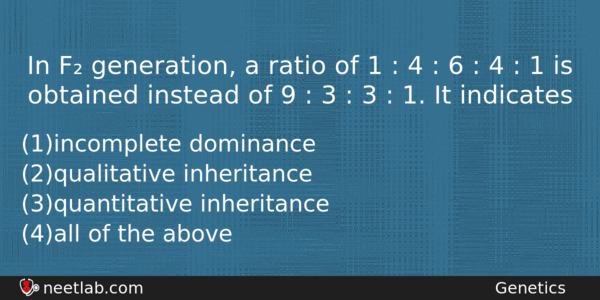| ⇦ | 
| ⇨ |
In F₂ generation, a ratio of 1 : 4 : 6 : 4 : 1 is obtained instead of 9 : 3 : 3 : 1. It indicates
Options
(a) incomplete dominance
(b) qualitative inheritance
(c) quantitative inheritance
(d) all of the above
Correct Answer:
quantitative inheritance
Explanation:
Quantitative inheritance is a type of inheritance controlled by one or more genes in which the dominant alleles have cumulative effect with each dominant allele expressing a part or unit of the trait, the full trait being shown only when all the dominant alleles are present. In quantitative inheritance the number of phenotypes is 3(1:2:1) when one polygene pair, 5(1:4:6:4:1) when two polygene pair and 7(1:6:15:20:15:6:1) when three polygene pairs are involved.
Related Questions: - How many ATP molecules are produced by aerobic oxidation of one molecule of
- Ducts of Bellini are present in
- Failure of descent of testis in scrotal sacs is called
- Which one of the following is a possibility for most of us in regard to breathing
- Function of human spleen is to
Topics: Genetics
(204)
Subject: Biology
(4253)
Important MCQs Based on Medical Entrance Examinations To Improve Your NEET Score
- How many ATP molecules are produced by aerobic oxidation of one molecule of
- Ducts of Bellini are present in
- Failure of descent of testis in scrotal sacs is called
- Which one of the following is a possibility for most of us in regard to breathing
- Function of human spleen is to
Topics: Genetics (204)
Subject: Biology (4253)
Important MCQs Based on Medical Entrance Examinations To Improve Your NEET Score
18000+ students are using NEETLab to improve their score. What about you?
Solve Previous Year MCQs, Mock Tests, Topicwise Practice Tests, Identify Weak Topics, Formula Flash cards and much more is available in NEETLab Android App to improve your NEET score.
Share this page with your friends

Leave a Reply